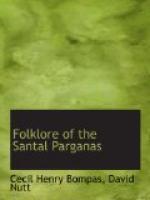At the sight their sister began to cry. Her friends asked what was the matter and she said a straw from the thatch had run into her eye, so they pulled down some of the thatch; she still went on crying and they again asked what was wrong; she said that she had knocked her foot against a stone in the ground; so they dug up the stone and threw it away. But she still went on weeping and at last confessed that the miserable-looking leaf-sellers were her brothers. Then her husband’s parents told her to be comforted, and they gave the brothers oil and bade them go and bathe and oil their bodies: but the brothers were so hungry that when they got to the bathing place they drank the oil and ate the oil cake that had been given to them; and came back with their skins as rough as when they went. So then they were given more oil and some of the household went with them and made them bathe and oil themselves properly and then brought them to the house and gave them new clothes and made them a feast of meat and rice. According to the custom of the country they were made to sit down in order of age and were helped in that order; when they had all been helped and had eaten, their sister said to them “Now brothers you come running to me for food, and yet you sacrificed me in the tank.” Then they were overwhelmed with shame: they looked up at the sky but there was no escape there; they looked down at the earth; and the earth split open and they all ran into the chasm. The sister tried to catch the youngest brother by the hair and pull him out, calling “Come back, brother, come back brother, you shall carry my baby about for me!” but his hair came off in her hand and the earth swallowed them all up. Their sister planted the hair in a corner of the garden and it is said that from that human hair, sabai grass originated.
XXVI. The Merchant’s Son and the Raja’s Daughter.
Once a merchant’s wife and a Raja’s wife were both with child and one day as they bathed together they fell into conversation, and they agreed that if they both bore daughters then the girls should be “flower friends” while if one had a son and one a daughter then the children should marry: and they committed the agreement to writing. A month or two later the Raja’s wife bore a daughter and the merchant’s wife a son. When the children grew up a bit they were sent to school, and as they were both very intelligent they soon learnt to read and write. At the school the boys used to be taught in an upstairs room and the girls on the ground floor. One day the boy wrote out a copy of the agreement which their mothers had made and threw It down to the girl who was below.
She read it and from that day they began to correspond with each other; love soon followed and they decided to elope. They fixed a day and they arranged that the boy should wait for the girl under a turu tree outside the town. When the evening came the girl made haste to cook her parents’ supper and then, when they went to bed, she had as usual to soothe them to sleep by rubbing their limbs; all this took a long time and the merchant’s son soon got tired of waiting, so he sang to the tree:—




